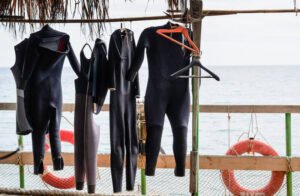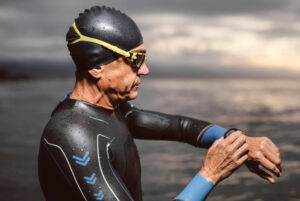When it comes to choosing a wetsuit, thickness and temperature are the two most important factors. The wrong wetsuit can leave you cold and uncomfortable, while the right one will keep you warm and protected. Wetsuits are made from neoprene, which is a type of synthetic rubber. They are available in different thicknesses, usually ranging from 2mm to 7mm. The thicker the wetsuit, the warmer it will be.
Water temperature is a major factor in deciding what thickness wetsuit you need. If you are surfing in warm water (70°F/21°C and above), a thinner wetsuit will be sufficient.
Key Questions:
- What neoprene thickness at what water temperature?
- How many millimeters thick must my wetsuit have?
Additionally, the article will provide a water temperature guide to help you make the best decision for your next surfing adventure.
Key Takeaways:
- Wetsuits range in thickness from 2mm to 7mm
- Warm or thick wetsuits reduce the danger of harm
- Consider a thicker wetsuit if the temperature is cold, there’s a lot of wind, you’re doing an activity with less movement, or you freeze up soon.
- A 3/2mm wetsuit will usually keep you comfortable in water temperatures around 20°C.
- A 4/3mm wetsuit will usually keep you comfortable in water temperatures around 15°C.
Wetsuit Thickness and Temperature
Neoprene is a type of synthetic rubber that is used to make wetsuits. Wetsuits are available in different thicknesses, usually ranging from 2mm to 7mm. The thicker the wetsuit, the warmer it will be. The following chart shows the relationship between water temperature and wetsuit thickness/type.
The thickness of the wetsuit has an impact on both thermal and elasticity. Both are important for fatigue management, in addition to our physical fitness. Wetsuits provide us with thermal protection from the cold water and help to maintain body temperature. In other words, a good wetsuit will keep us warm in cold water conditions. The neoprene material is also elastic, which allows for a full range of motion while surfing.
- Choosing the right wetsuit thickness is important for both comfort and safety.
- If the wetsuit is too thin, you may get cold; you may get overheated if it’s too thick.
- It is always best to err on the side of caution and go with a thicker wetsuit if you are unsure.
So when buying your wetsuit, look for the right balance of thickness and elasticity. In case of doubt, however, you should opt for the warmer and thus usually somewhat thicker neoprene variant.
How the Risk of Injury Is Associated With Wetsuit Thickness
Surfing is a physically demanding sport that puts a lot of strain on the body. As a result, injuries are common among surfers. Wearing the wrong wetsuit can increase the risk of injury. For example, if the wetsuit is too thin, you may get cold, and your muscles may tense up, which can lead to cramping. If the wetsuit is too thick, you may overheat and become dehydrated.
The ideal wetsuit thickness depends on the water temperature. In general, the colder the water, the thicker the wetsuit should be.
- For example, in warm water (70°F/21°C and above), a 2mm wetsuit may be sufficient.
- In cold water ( below 60°F/15°C), a 5mm or 7mm wetsuit may be necessary.
Warm or thick wetsuits reduce the danger of harm. Muscles, ligaments, and tendons are warmer, more flexible, and more elastic as a result of being heated.
- As a rule of thumb: The thicker the neoprene, the warmer and less flexible the wetsuit will be.
A too thick wetsuit, on the other hand, can cause problems because it does not allow the body to cool down through sweating and can thus lead to overheating. In addition, the thicker neoprene layers make it more difficult to move and can therefore reduce performance. Let’s look at the characteristics that will affect your ideal wetsuit thickness, including the activity you’re doing, the water temperature, and sensitivity.
Activity
The first thing to consider when choosing a wetsuit thickness is the activity you’ll be doing. If you’re going to be surfing in warm water, you won’t need as much insulation as someone who is going to be diving in cold water. Some important questions to ask include:
- Will you be moving around a lot (the more active you are, the more heat your body produces)?
- Will you spend most of your time underwater or on the surface (the body loses heat much faster in water than in air)?
The recommended suit thickness for a given water temperature depends on what sport you are doing – for active surface sports like surfing, you can usually use a thinner suit than for scuba diving, for example.
Water temperature
The next thing to consider is the water temperature. Obviously, the colder the water, the thicker your wetsuit will need to be. But it’s not that simple. The type of activity you’re doing and how long you’ll be in the water also play a role in how cold you’ll get.
- For example, if you’re surfing in cold water, you’ll be moving around a lot and generating heat, so you won’t need as much insulation as someone who is diving in the same water.
- Water temperature is the main factor and the most obvious one – in colder water, you need a thicker wetsuit.
When investing in a wetsuit, you should consider the depth of the dive and the water’s temperature; as you descend deeper into the water, it becomes colder in most regions of the world. In addition, due to the high pressure in the water, neoprene gas bubbles are compressed, reducing the effectiveness of the wetsuit.
Sensitivity to Cold
The next factor to consider is your sensitivity to cold. Some people feel the cold more than others and will need a thicker wetsuit to stay warm. If you’re not sure how sensitive you are too cold, err on the side of caution and choose a thicker wetsuit.
There’s no shame in being cold – it’s better to be cold in a 5mm wetsuit than to be hypothermic in a 3mm wetsuit. In general, women tend to feel the cold more than men, so they may need a thicker wetsuit. In addition to these main factors, there are a few other things to consider when choosing a wetsuit thickness.
Duration of Activity
The longer you’ll be in the water, the more heat your body will lose, and the thicker your wetsuit will need to be. If you’re only going to be in the water for a short time (less than an hour), you can get away with a thinner wetsuit than if you’re going to be in the water for a long time (several hours).
However, even if you’re only going to be in the water for a short time, it’s still better to err on the side of caution and choose a thicker wetsuit if you’re not sure.
Wetsuit Fit
Another factor to consider is the fit of your wetsuit. A well-fitting wetsuit will be more effective at keeping you warm than a loose-fitting one. If your wetsuit is too big, water can circulate, and you’ll lose heat much faster.
On the other hand, a wetsuit that’s too tight can be uncomfortable and make it difficult to move. The best way to find a wetsuit that fits well is to try it on in a store. If you’re buying online, make sure to check the size chart and return policy in case you need to exchange it for a different size.
Type of Wetsuit
Finally, the type of wetsuit you choose will also affect how warm you stay in the water. There are two main types of wetsuits: fullsuits and springsuits.
- Fullsuits cover your entire body and have long sleeves and legs.
- They’re the best type of wetsuit for keeping you warm, but they can be more difficult to put on and take off.
Springsuits only cover your torso and have short sleeves and legs. They’re easier to put on and take off than fullsuits, but they don’t provide as much insulation.
So, which type of wetsuit should you choose? It depends on the water temperature and your sensitivity to cold. In general, springsuits are better for warm water, and fullsuits are better for cold water. But if you’re sensitive to cold, you might need a fullsuit even in warm water.
Air Temperature
Another factor to consider is the air temperature. If it’s cold outside, you’ll lose heat faster, and you’ll need a thicker wetsuit. In general, a thicker wetsuit is better than a thinner one, but if you’re going to be in the water for a long time, you might need a thicker wetsuit than if you’re only going to be in the water for a short time.
However, even if you’re only going to be in the water for a short time, it’s still better to err on the side of caution and choose a thicker wetsuit if you’re not sure.
Wind Speed
The next factor to consider is wind speed. If it’s windy, you’ll lose heat faster, and you’ll need a thicker wetsuit.
- In general, a thicker wetsuit is better than a thinner one, but if you’re going to be in the water for a long time, you might need a thicker wetsuit than if you’re only going to be in the water for a short time.
- However, even if you’re only going to be in the water for a short time, it’s still better to err on the side of caution and choose a thicker wetsuit if you’re not sure.
Activity Level / Rigor of Exercise
The last factor to consider is your activity level. If you’re going to be swimming or surfing, you’re going to need a thicker wetsuit than if you’re just going to be snorkeling. The reason for this is that when you swim or surf, your body is constantly moving and losing heat.
However, even if you’re only going to be snorkeling, it’s still better to err on the side of caution and choose a thicker wetsuit if you’re not sure. Now that you know all the factors to consider, let’s look at the different types of wetsuits and how they can keep you warm in the water.
Consider a thicker wetsuit if the temperature is cold, there’s a lot of wind, you’re doing an activity with less movement, or you freeze up soon. Many manufacturers provide their own temperature suggestions, which vary somewhat from those above.
Wetsuit Thickness In Relation to Ambient Conditions
Wetsuits are made in a variety of thicknesses to suit different conditions. The thicker the wetsuit, the more insulation it will provide and the warmer you will be in the water. However, thicker wetsuits are also more difficult to put on and take off and can make you feel claustrophobic.
- 1 to 2mm Spring/Shorty
- It is as thin as a wetsuit comes and will keep your body protected
- Minimal exhaustion and no overheating
- Board Shorts and a wetsuit top are also an option
- 3mm
- It can be worn in the winter, depending on how early into the colder months you’re going to be surfing
- It can be worn in the summer – especially if in the UK or Ireland
- It can be worn during winter in some spots around Europe
- 4mm
- Coldwater surfing
- Booties and gloves become an option
- 5mm
- Deep winter and cold-water surfing
- Booties and gloves become a necessity
- Wetsuit hoods become an option
- 6mm/7mm
- Extremely cold surfing conditions
- Serious surfers who track winter swells
- Booties, gloves, and hoods become a necessity
The water temperature is the most important deciding factor for wetsuit thickness.
- Your body temperature will drop quite rapidly in water that is colder than 20°C.
- At this point, you will start to feel cold and uncomfortable, and if you don’t have a wetsuit on, you will start to feel hypothermic.
Wetsuits work by trapping a layer of water between your skin and the neoprene. Your body then heats this layer of water, which in turn helps to keep you warm. The thicker the wetsuit, the more insulation it provides, and the warmer you will be in the water. However, thicker wetsuits are also more difficult to put on and take off and can make you feel claustrophobic.
Checklist of a Wetsuit Thickness
When purchasing a wetsuit, deciding on a thickness can be tricky and is often the most common question asked. There are multiple questions you should ask yourself before deciding on a thickness. By answering these questions, you can help to narrow down your choices and find the perfect wetsuit for you.
- What is the water temperature of my destination at the chosen time of year?
- What is my subjective perception of the cold?
- Is it a high-quality wetsuit?
- What is my water sport?
- Is there an inner lining such as thermal fleece?
High-quality wetsuits will always offer a better fit, more flexibility, and more warmth than low-quality wetsuits. Durability is also important, as a wetsuit that falls apart quickly is not only a waste of money but can also be dangerous. High-quality wetsuits prove to be durable and offer a multitude of characteristics that increase comfort and safety while in the water, including:
Durable Materials
High-quality wetsuits use neoprene that can withstand years of wear and tear. The neoprene used in wetsuits is a synthetic rubber that is resistant to degradation from sunlight, heat, and saltwater. Low-quality wetsuits use lower-quality neoprene that will degrade much quicker, leaving you with a hole in your wetsuit and cold water rushing in.
Quality Zippers
Wetsuits need to be snug-fitting to provide the most insulation, but they also need to be easy to take on and off. High-quality wetsuits use YKK zippers, which are the strongest and most durable zippers available. Low-quality wetsuits will use lower-quality zippers that are more likely to break and will be more difficult to operate.
Inner Linings – Polypropylene, Nylon, or Thermal Fleece
Wetsuits can have different types of inner linings depending on the intended use and conditions. The three most common materials used for inner linings are polypropylene, nylon, and thermal fleece. Of these three, thermal fleece provides the best insulation against the cold. Polypropylene and nylon are less effective but dry faster and are therefore more comfortable to wear.
Reinforced Seams – Flatlock or Blindstitched
Seams are an important part of a wetsuit as they determine its flexibility, comfort, and durability. There are two types of seams – flatlock and blindstitched. Flatlock seams are less durable but more flexible, while blindstitched seams are more durable but less flexible.
Frequently Asked Questions
Here are some frequently asked questions that may help you to decide on a wetsuit thickness.
Depending on the water temperature and your own body temperature, wetsuits of different thicknesses will keep you warmer for longer. A 3/2mm wetsuit will usually keep you comfortable in water temperatures around 20°C.
The seam of a 3/2 suit is flatlock, which permits water to seep in. As a result, 3/2 suits with flatlock seams function best in temperatures that reach 68 degrees F and above. Meanwhile, sealed seams are more waterproof than flatlock but not as leakproof as sealed and tacked seams.
The season you’re in will also affect how warm you need your wetsuit to be. If you’re surfing in winter, a 3mm wetsuit may not be enough to keep you warm.
So for a winter wetsuit, you’ll be looking for a 4/3mm or more, and for summer, opt for just 2 or 3mm of neoprene. In this case, a 5mm or 7mm wetsuit would be a better choice.
Based on your wetsuit thickness, you will be able to stay in colder water for longer periods of time. A 4/3mm wetsuit will usually keep you comfortable in water temperatures around 15°C.
A high-quality 3/2 full suit with booties or a 4/3 wetsuit is good for temperatures of 59F–64F (15C–18C). A 4/3 wetsuit with booties is okay in these temperatures, but for longer exposure, a 5/3 wetsuit with booties is best.
2mm wetsuits are not as warm as thicker wetsuits, but they are still good for warmer water temperatures. They are also more flexible and comfortable to wear. A 2mm wetsuit will usually keep you comfortable in water temperatures around 25°C.
A 3mm or 2mm shorty for summer, a 3mm fullsuit with watertight seams for dawn patrols, and general later spring and early Autumn surfing. A 4mm suit for early spring and late Autumn before the winter really kicks in.
A 5mm wetsuit for winter in most locations is fine, especially when coupled with boots, gloves, and a hood.
Wetsuits work by trapping a layer of water next to your skin. Your body then heats up this layer of water, and the wetsuit insulation prevents the heat from escaping. This trapped layer of water also acts as a buffer against the cold water outside the wetsuit.
The various layers of the wetsuit trap air, the wetsuit traps water against your skin, and the neoprene outer layer insulates heat within the suit, ensuring you stay warm while allowing you to participate in all of your water activities.
ConclusionThe activity, water temperature, and sensitivity to cold are the most crucial elements to consider. Depending on your weight, level of activity, and the temperature outside, wetsuit suitability may vary by 5-10°C.
- 0–3°C | 6mm / 7mm – deep winter warriors
- 4–7°C | 4mm / 5mm / 6mm – the bitterly cold brave
- 8-11°C | 3mm / 4mm – crisp water comrades
- 12-17°C | 2mm / 3mm – seasonally smart surfers
- 18–26°C | UV lycra / Spring suit – endless summer embracers







